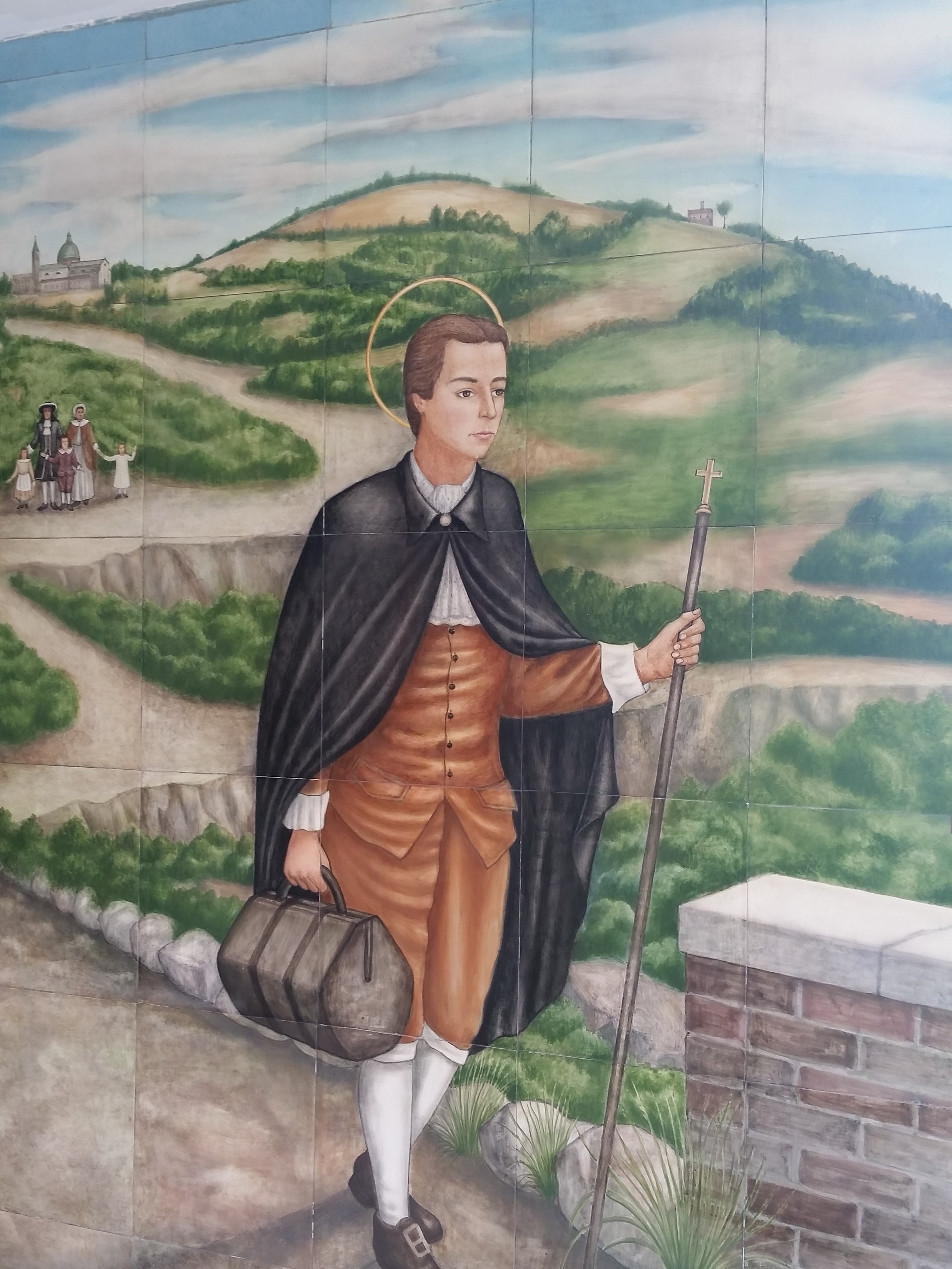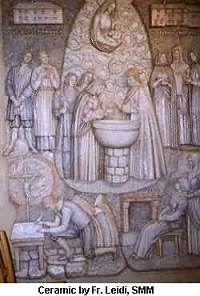Saint Louis Marie de Montfort
An Often Misunderstood Saint Part III: Expulsion from the Diocese of Poitiers
Fr. Patrick Gaffney, SMM
“The young priest was not to go to the foreign missions
but armed with the title
“Missionary Apostolic”
he was to return to
the bloody battleground of the Church in France,
for it was there that the Vicar of Christ needed him. ”
S aint Louis de Montfort was given permission to undertake ministry in the diocese of Poitiers when Bishop Antoine Girard de la Bournat, a good friend of Madame de Montespan, was still the Ordinary. The Bishop died in March, 1702, succeeded shortly by Jean Claude de la Poype, a good friend of the Sulpicians and also of Father Louis Grignion.
There were two principal incidents which contributed to the expulsion of Father de Montfort from Poitiers in 1706. The first has probably been exaggerated for although it did result in a prohibition to celebrate Mass, the restriction was rescinded only a few hours later. More-over, it was almost certainly after this misunderstanding that the Bishop concurred with the priest’s decision to leave the hospital and undertake the preaching of parish missions and retreats in the diocese. Nonetheless, the incident must be counted as another example of “singularity” which Montfort’s detractors would not forget.
Probably sometime during the summer of 1704, a group of young boys who had been swimming in the River Clain began harassing some washerwomen along the banks. The boys’ conduct became lewd and nasty as the young priest from Montfort happened to be walking by. Since polite invitations to the youngsters to move on solved nothing, Father Grignion took from his backpack a small penitential lash, (a quite ordinary means of self-mortification in those days) and used it to force the boys to leave. One of them went screaming to his mother, complaining that the Father from Montfort had scourged him. The mother, furious, ran to the Chancery office nearby and exploded in anger before the bishop. And he was too quick to believe her. However, the prohibition to celebrate Mass was lifted that same day when the Bishop learned the truth. Nonetheless, the entire affair only contributed to what was called both by admirers and detractors, “strange, extraordinary ways” of the Father from Montfort.
The second incident was far more serious and precipitated Montfort’s dismissal. In 1705, having left the direction of the General Hospital because of the opposition of the board of directors, the young priest devoted himself entirely to preaching. He reveled in it. He excelled in it. He became known in Poitiers as one of the truly great preachers of the time. It would be difficult to deny that some of the parish priests in the area resented his popularity and success.
Father de Montfort employed grandiose audio-visual means to proclaim the Word: huge, colorful, processions of the Blessed Sacrament, with banners flying, bands playing, crowds singing. The hymns were composed by the missionary and put to [lifting] popular tunes. It was not surprising, therefore, that he would dramatize the evil of pornography and magic which were, so it is said, widespread in the region. In the Fall of 1705, he called upon the citizens of Poitiers who were attending a mission at Calgary Church to collect all the evil books they could find and throw them into a large pile of straw, outside the Church. The bonfire would be lit at the end of the mission. And at the very spot, Father de Montfort planned to erect a large cross commemorating not only the parish mission but also the victory of the kingdom of God over the disobedience of the devil.
Although it sounds excellent, the project was clearly chancy. Yet, as far as the missionary was concerned, it had been done by St. Paul at Ephesus, so why not in Poitiers? And as Montfort’s famous proverb goes, “if you are afraid to take a risk for God you will never do anything great for Him.” One of the priests of the diocese who was helping Father de Montfort during the mission, thought the whole book-burning idea was preposterous and even more so, dangerous. It was playing into the hands of anyone who wanted to make mischief. All those pornographic books and pictures piled up in a mound of straw?
And the worst did happen. While the saint was preaching inside the Church, a group of young people at the hay pile dressed up a scarecrow with sausage earrings and necklaces. Decked out in such finery, the bawdy female harlequin was dubbed “the devil.” After all, hadn’t the preacher planned on burning a straw effigy of a worldly person along with the lewd books and pictures? And how eager they were to light the bonfire to send Satan back to hell!
Jean Claude de la Poype was visiting at the court of Versailles at the time. The priest who opposed the idea from the start, together with an angry woman (who for some reason was refused a paper mission cross attesting to having participated in the mission) immediately brought the news of “Montfort’s wild plans” to one of the two vicars general, Monsignor de Villeroi.
Burn a scarecrow devil adorned with sausages for her attire? And at the entry to the Church? The vicar jumped into his carriage, rushed to the scene, arriving just as Louis de Montfort had finished his sermon. Before the large crowd gathered inside and outside the Church, the representative of the Bishop furiously railed against the preacher, denouncing him for his outlandish, stupid, blasphemous plans. When the infuriated official turned on his heels and left the church, Father de Montfort delivered one of his most beautiful sermons: “My friends, we planned to erect a cross at the door of this church. God has not willed it, our superiors oppose it. Let us plant the cross in the middle of our hearts. It will be better planted there than any-where else.” And then to the amazement of all, he continued with the recitation of the rosary, as was scheduled. He had again been publicly disgraced and was deeply hurt. Yet his incredible trust in the Providence of God gave him an amazing peace. Montfort apparently did not yet know the magnitude of the calamity when he continued so peacefully with the scheduled prayers.


Tile mural depicting a scene of St Louis de Montfort’s Life and a special Ceramic Scene
This mural (image #1) appears immediately outside the chapel in Montfort’s Spiritual Center. This first scene depicts Louis Grignion’s leaving to begin his studies in Paris. Louis Grignion walked to his destinations and this journey was no different. It is over 250 miles between the towns. He would give up his clothes and money along the way.
The second image is located in Montfort-sur-Meu, France and it is a ceramic scene of St. Louis de Montfort’s Baptism. Fr. Montfort spoke greatly about Baptism and to honor him, Father Keramik von A. Leidi, SMM created this scene that is visible today. If you look closely, you’ll see Our Lady and Our Lord above the font at the point of Louis Grignion’s Baptism.
“My friends, we planned to erect a cross at the door of this church. God has not willed it, our superiors oppose it. Let us plant the cross in the middle of our hearts. It will be better planted there than any-where else.”
Upon his arrival at the scene, Monsignor de Villeroi had forbidden the burning of the devil scarecrow since the bonfire would be – so he thought – nothing more than superstition. The young people, breaking out in silly grins, then pounced on the mound of pornography and ran away with every tidbit they could find! Grandet says there were about 500 books and 500 pictures. Although the number is most probably exaggerated, nonetheless, what a disaster for Saint Louis de Montfort! What the holy missionary had intended to prevent – the spread of indecent literature and books on magic – had only been worsened. When faced with the news, he publicly apologized for the scandal he had unwittingly occasioned.
However, the other vicar general, Monsignor de Revol, Bishop-elect of Oloron, was appalled at the actions of his colleague and made it a point to be present at the closing of the mission the following day. He delivered a grandiose sermon on the privilege of the people of Poitiers to have present among them a missionary of such stature and holiness as Father Louis Marie Grignion. Monsignor de Revol firmly believed that the whole situation would have gone off very well had only Monsignor de Villeroi – not well informed and never a friend of Montfort—not intervened.
Nonetheless, the damage was done. The Villeroi family was extremely powerful at Versailles. (Some years later, Louis XIV would name Father Villeroi to the archbishopric of Lyons.) Prejudiced and exaggerated news of the incident was giggled about at the royal court. A well-meaning Jesuit from Poitiers wrote to St. Sulpice seminary jokingly narrating the silliness of the whole event of the bawdy harlequin scarecrow; the administrators of the highly reputable seminary were definitely not amused by the antics of an alumnus. When the bishop returned from Versailles to Poitiers, he was handed report after report complaining about the burning of the scarecrow devil outside Calvary Church and the subsequent scandal of pornography falling into the hands of young people. And all because of Father de Montfort! The missionary’s friend, Monsignor de Revol, was by that time installed in his new diocese in the south of France, there was no influential member of the Poitiers clergy to intercede for him.
Not long after Claude de la Poype arrived back in Poitiers, on the day that the missionary had begun a retreat to the Dominican nuns in Poitiers, Father de Montfort received a note from the Bishop ordering him to leave the diocese immediately.
Montfort, both crestfallen and peaceful, went to his Jesuit confessor, Father de la Tour, and confided to him the decision of the Bishop, placing it in the context of all the repeated difficulties he had experienced in his few years of ministry. The Father from Montfort revealed to his director a burning desire to visit the Holy Father. He yearned not only to show his total allegiance to the Vicar of Christ but to seek his advice and to volunteer for the foreign missions. Ministering in France, especially preaching parish missions and retreats, had become too painfully re- stricted.
What a cross the Pope would lay on Father de Montfort’s shoulders! The young priest was not to go to the foreign missions but armed with the title “Missionary Apostolic,” he was to return to the bloody battleground of the Church in France, for it was there that the Vicar of Christ needed him. It was with a sense of joy, and even with a spirit of exultation that Father de Montfort took up again his preaching vocation among the Catholics of his native land.
A day or so after his return to Poitiers from his exhausting and debilitating pilgrimage on foot to Rome (Fall, 1706), he received his “Welcome Home!” note from Bishop de la Poype: leave the diocese without delay. Seven years later (1711), when Father de Montfort’s renown as a holy missionary was widespread, he again stopped at Poitiers, this time to visit the first two Daughters of Wisdom, Marie Louise Trichet and Catherine Brunet. The day after his arrival, when the news of his presence in the diocese reached the “very generous and spiritual Shepherd,” Bishop de la Poype, Montfort was told to get out within twenty-four hours. The good Bishop’s decision to rid Poitiers of this troublemaker priest was never rescinded. The Father from Montfort would never be able to set foot again within the diocese.
(To Be Continued)


